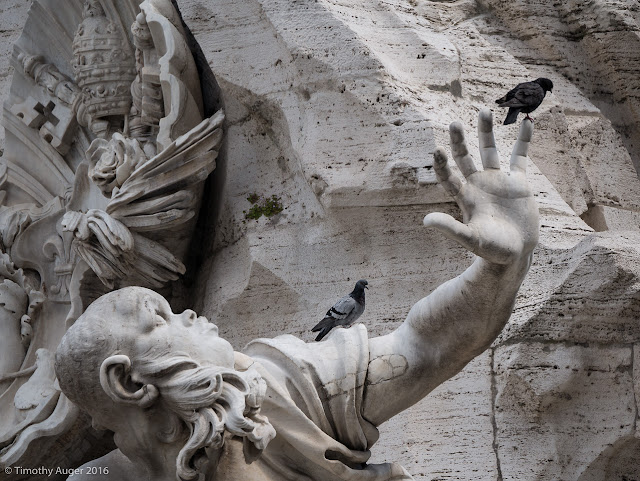 |
| You're never far from a church, in the old centre of Rome. |
We took the train from Florence to Rome, a
Red Arrow service fully the match of any long-distance train I’ve used in
Europe. Arrival at Termini was followed by a laborious, exhausting, panting, suitcase-dragging
trek to a hotel further away than it looked on the map. I say ‘hotel’ – it was originally
just an apartment in a fairly modern block. The bedrooms were a good size, and
each had its own bathroom. Sadly they weren’t adjoining (en suite, as the
daytime TV programmes put it), and a night-time pee meant opening and shutting
doors as silently as possible and crossing the common corridor – and the need
for some form of clothing.
I’ve been to Rome many times. I can’t claim
to be a Rome expert. My travelling companion knows a lot more about it than I
do. But I can find my way around.
In a ten-day visit, It’s impossible to
absorb more than a tiny fraction of the variety of Rome’s historic art and
architecture. Charles Dickens wrote about the city in his ‘Pictures from
Italy’. After describing some of the ‘holy’ relics housed in many of the churches,
he says:
‘The rest is a vast wilderness of
consecrated buildings of all shapes and fancies, blending one with another; of
battered pillars of old Pagan temples, dug up from the ground and forced, like
giant captives, to support the roofs of Christian churches; of pictures, bad,
and wonderful, and impious, and ridiculous; of kneeling people, curling
incense, tinkling bells, and sometimes (but not often) of a swelling organ; of
Madonne, with their breasts stuck full of swords, arranged in a half-circle
like a modern fan; of actual skeletons of dead saints, hideously attired in
gaudy satins, silks, and velvets trimmed with gold: their withered crust of
skull adorned with precious jewels, or with chaplets of crushed flowers;
sometimes, of people gathered round the pulpit, and a monk within it stretching
out the crucifix, and preaching fiercely: the sun just streaming down through
some high window on the sail-cloth stretched above him and across the church,
to keep his high-pitched voice from being lost among the echoes of the roof.
Then my tired memory comes out upon a flight of steps, where knots of people
are asleep, or basking in the light; and strolls away, among the rags, and
smells, and palaces, and hovels, of an old Italian street.
 |
| Pope Francis doing his stuff of a Sunday morning. The window is quite distant, seen from the Piazza, and you need a longer telephoto lens than anything I had in the bag. |
 |
| Above (all three): frescoes on the ceiling and dome of Il Gesu, the mother church of the Jesuits. Over-the-top literally and aesthetically, but quite spectacular. |
 |
| Detail of Bernini's 'Four Rivers' fountain in Piazza Navona. This is the River Plate. |
Religion’s lost much of its hold these
days, and anyway most of modern Rome was developed well after Charles Dickens’s
time. Outside the historic core, a lot of it looks like any other big Italian
city. But it’s not hard to make a connection between his account and what you
see today. Perhaps one of the differences is the vast number of foreign
tourists. Dickens describes tourists in Rome in satirical terms, but in the 19th
century there were not that many of them. On a Sunday morning, when today’s
Pope makes his appearance at the Vatican balcony to bless the crowd, I would
judge that Italians are a relatively small minority. The impact of mass tourism
is everywhere, with vast quantities of globalized tourist tat indistinguishable
from the stuff you see in London. Made in China or wherever, certainly not in
Italy.
 |
| Mosaic decoration in Santa Maria in Trastevere, Rome (1140-43). |
Of course, those parts of Rome dating back
to the Renaissance and mediaeval times, not to mention ‘Ancient Rome’, carry
the most potent historical message. But many of the streets we now see as
typically Italian were built in the late 19th or early 20th
centuries. Nevertheless they are sufficiently different from their London
contemporaries that we see them as ‘typically Italian’, particularly those big
apartment buildings planned around a courtyard with a grand, communal street
entrance, generally with a formal classical façade.
Prices have shot up. In the early seventies
you could get a pretty good lunch with wine for around 3000 lire. Rome was
cheap. Now the prices are comparable with London, much of the décor homogenized
vaguely international, and the quality not always reliable. A bit like Paris in
this respect. I’m very much in favour of the UK’s membership of the European
Union, but the Euro currency is a different thing: almost anyone in Rome will
tell you of the sneaky price increases that took place on the transition from
the Lira to the common European currency. The same thing happened in the UK,
although perhaps not as brazenly, when we moved from pounds, shillings and
pence to decimal currency.





No comments:
Post a Comment